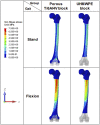Biomechanical Comparison Between Porous Ti6Al4V Block and Tumor Prosthesis UHMWPE Block for the Treatment of Distal Femur Bone Defects
- PMID: 35866028
- PMCID: PMC9294404
- DOI: 10.3389/fbioe.2022.939371
Biomechanical Comparison Between Porous Ti6Al4V Block and Tumor Prosthesis UHMWPE Block for the Treatment of Distal Femur Bone Defects
Abstract
Purpose: The management of bone defects is a crucial content of total knee revision. This study compared the biomechanical performance of porous Ti6Al4V block and tumor prosthesis UHMWPE block in treating distal femoral bone defects. Methods: The finite element models of AORI type 3 distal femoral bone defect treated with porous Ti6Al4V block and UHMWPE block were established. Sensitivity analysis was performed to obtain the appropriate mesh size. The biomechanical performance of treatment methods in bone defects were evaluated according to the peak stress, the Von Mises stress distribution, and the average stresses of regions of interest under the condition of standing on one foot and flexion of the knee. Statistical analysis was conducted by independent samples t-test in SPSS (p < 0.05). Results: In the standing on one-foot state, the peak stress of the porous Ti6Al4V block was 12.42 MPa and that of the UHMWPE block was 19.97 MPa, which is close to its yield stress (21 MPa). Meanwhile, the stress distribution of the UHMWPE block was uneven. In the flexion state, the peak stress of the porous Ti6Al4V block was 16.28 MPa, while that of the UHMWPE block was 14.82 MPa. Compared with the porous Ti6Al4V block group, the average stress of the region of interest in UHMWPE block group was higher in the standing on one foot state and lower in the flexion state (p < 0.05). Conclusion: More uniform stress distribution was identified in the porous Ti6Al4V block application which could reserve more bone. On the contrary, uneven stress distribution and a larger high-stress concentration area were found in the UHMWPE block. Hence, the porous Ti6Al4V block is recommended for the treatment of AORI type 3 distal femoral bone defect.
Keywords: UHMWPE block; bone defect; distal femur; finite element analysis; metal block; total knee revision.
Copyright © 2022 Zhang, Liu, Han, Zhang, Chen, Ma, Li, Chen and Wang.
Conflict of interest statement
The authors declare that the research was conducted in the absence of any commercial or financial relationships that could be construed as a potential conflict of interest.
Figures







References
-
- Bagudanch I., García-Romeu M. L., Ferrer I., Ciurana J. (2018). Customized Cranial Implant Manufactured by Incremental Sheet Forming Using a Biocompatible Polymer. Rpj 24, 120–129. 10.1108/rpj-06-2016-0089 - DOI
-
- Burastero G., Pianigiani S., Zanvettor C., Cavagnaro L., Chiarlone F., Innocenti B. (2020). Use of Porous Custom-Made Cones for Meta-Diaphyseal Bone Defects Reconstruction in Knee Revision Surgery: a Clinical and Biomechanical Analysis. Arch. Orthop. Trauma Surg. 140, 2041–2055. 10.1007/s00402-020-03670-6 - DOI - PubMed
LinkOut - more resources
Full Text Sources

